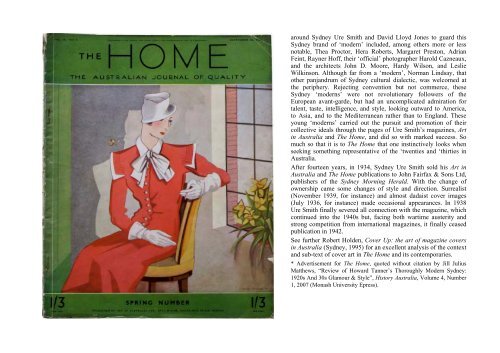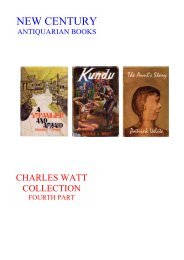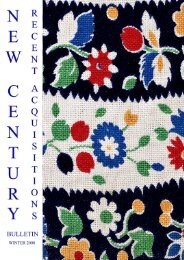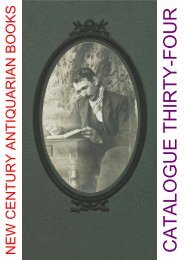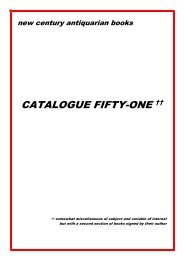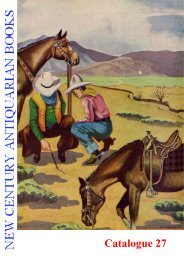Catalogue 63 New Century Antiquarian Books Late Spring 2012
Catalogue 63 New Century Antiquarian Books Late Spring 2012
Catalogue 63 New Century Antiquarian Books Late Spring 2012
Create successful ePaper yourself
Turn your PDF publications into a flip-book with our unique Google optimized e-Paper software.
around Sydney Ure Smith and David Lloyd Jones to guard this<br />
Sydney brand of ‘modern’ included, among others more or less<br />
notable, Thea Proctor, Hera Roberts, Margaret Preston, Adrian<br />
Feint, Rayner Hoff, their ‘official’ photographer Harold Cazneaux,<br />
and the architects John D. Moore, Hardy Wilson, and Leslie<br />
Wilkinson. Although far from a ‘modern’, Norman Lindsay, that<br />
other panjandrum of Sydney cultural dialectic, was welcomed at<br />
the periphery. Rejecting convention but not commerce, these<br />
Sydney ‘moderns’ were not revolutionary followers of the<br />
European avant-garde, but had an uncomplicated admiration for<br />
talent, taste, intelligence, and style, looking outward to America,<br />
to Asia, and to the Mediterranean rather than to England. These<br />
young ‘moderns’ carried out the pursuit and promotion of their<br />
collective ideals through the pages of Ure Smith’s magazines, Art<br />
in Australia and The Home, and did so with marked success. So<br />
much so that it is to The Home that one instinctively looks when<br />
seeking something representative of the ‘twenties and ‘thirties in<br />
Australia.<br />
After fourteen years, in 1934, Sydney Ure Smith sold his Art in<br />
Australia and The Home publications to John Fairfax & Sons Ltd,<br />
publishers of the Sydney Morning Herald. With the change of<br />
ownership came some changes of style and direction. Surrealist<br />
(November 1939, for instance) and almost dadaist cover images<br />
(July 1936, for instance) made occasional appearances. In 1938<br />
Ure Smith finally severed all connection with the magazine, which<br />
continued into the 1940s but, facing both wartime austerity and<br />
strong competition from international magazines, it finally ceased<br />
publication in 1942.<br />
See further Robert Holden, Cover Up: the art of magazine covers<br />
in Australia (Sydney, 1995) for an excellent analysis of the context<br />
and sub-text of cover art in The Home and its contemporaries.<br />
* Advertisement for The Home, quoted without citation by Jill Julius<br />
Matthews, “Review of Howard Tanner’s Thoroughly Modern Sydney:<br />
1920s And 30s Glamour & Style”, History Australia, Volume 4, Number<br />
1, 2007 (Monash University Epress).


